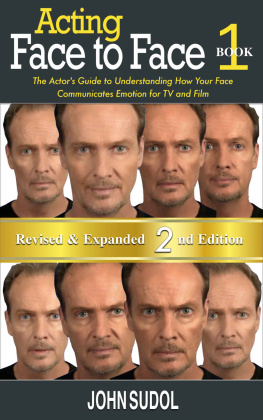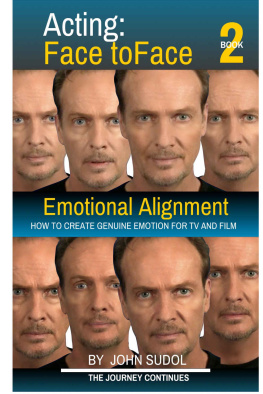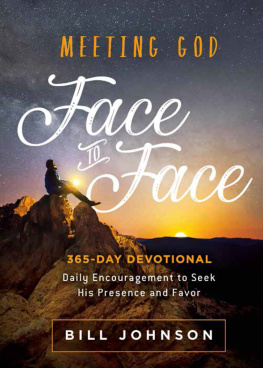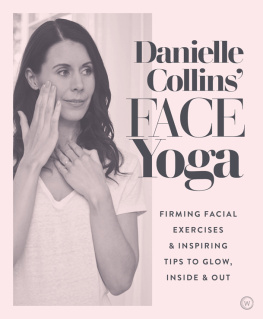Contents
Acting: Face to Face
The Actors Guide to Understanding
How Your Face Communicates Emotion
for TV & Film
REVISED & EXPANDED 2ND EDITION
By John Sudol
Copyright 2013, 2021 John Sudol
All rights reserved. No portion of the book may be reproduced or utilized in any form or by any means, electronic or mechanical, including photocopying, recording, or by any other information storage and retrieval system, without permission in writing from John Sudol.
Edited by
First Edition
Lisa Martel
Second Edition
Leslie Hough
https://www.emotiontrainingcenter.com/books
https://www.emotiontrainingcenter.com/store
https://www.emotiontrainingcenter.com/etc-licensing
How can we remember our ignorance, which our growth requires, when we are using our knowledge all the time? Henry Thoreau
Create your own method. Dont depend slavishly on mine. Make up something that will work for you! But keep breaking traditions, I beg you...
Constantine Stanislavsky
The actor must understand the complexity of emotional experience in attempting to convey an emotion in performance. The discussion of deception may help him prevent his personal feelings from leaking through in his performance. When the actor is feeling his way into the emotional experience of a character, he needs to be sure that his expression of that emotion is commonly understood. Dr. Paul Ekman
In loving memory of my father Jack and brother Gary, who left us all far too soon. I wish I could have seen their faces when reading this book
Other books and online course by John Sudol:
Ebook/Paperback: Acting: Face to Face 2:
Emotional Alignment
Emotional Alignment Course: www.emotiontrainingcenter.com

Message from John
I would like to take a few moments to share some of my thoughts about the current times and this second edition. I promise Ill be brief.
When Acting Face to Face first came out 2013, I received a lot of great feedback from actors, directors, managers and casting directors, it also became a #1 Best Seller on Amazon. And, Backstage named it one of Eleven Amazing Books for the On-Camera Actor.
Ive received hundreds of e-mails from actors all over the country and around the world. Many were congratulatory. Some were more personal and often quite moving. I heard from actors who went into great detail about the struggles, frustrations and disappointments they experienced while working on-camera, as well as the relief they felt on knowing that what they suspected was missing could be recaptured. All of the support, acknowledgment and praise has meant a great deal to me.
However, what Ive found most interesting was that the positive feedback was not only from actors and others in the movie making industry, the book was reaching a whole new audience. This new audience included financial managers, CEOs, tech entrepreneurs and salespeople, which makes absolute sense. These are all people who rely on their facial communication to lead and inspire their teams, clients and investors.
As I write this, we are still in the middle of the pandemic, waiting for the vaccine to be distributed. Its been a horrible year for so many with illness, jobs lost, production stopped and being stuck at home. If we choose to go out, we must wear a mask. Now the thing about masks, masks keep us safe, but they also, of course, cover many of the facial muscle groups that we utilize to communicate effectively. Relying solely on the eyes to determine what someone is thinking or feeling has led to more frustration than communication. It is also a prime example of how hard it is to read someone when all you have is the eyes.
In this new second edition, I have revised the Myths and Misconceptions chapter and I investigate those challenges of mask-wearing. I also go deeper into EYE COMMUNICATION - what the eyes can say and what they cant.
The science of emotion and facial expression is constantly expanding and I have continued researching. This is reflected in updates throughout the book. Ive also added over 35 new photos to illustrate specificity and subtlety of emotional expression. But, the biggest change is the addition of 3 NEW chapters. Two of these chapters are dedicated solely to a mini version of my proprietary Emotion Screen Test (EST)*. I wanted to give all those who read this book something specific to take away- action steps that will give greater insight into how you create and reveal emotion on a truly personal level.
The EST is a guided in-depth self-evaluation of your own facial expressions. Its main purpose is to help you clearly evaluate your emotion creating and revealing strengths and weaknesses. The aha moments that almost always come from doing the EST (even the short one) can be an incredible motivator for further, deeper work.
Most of all, I want to emphasize that I have written this book for you. I want nothing more than for you to succeed in your career goals. For me, its never been about achieving massive fame and fortune, but rather achieving true understanding of how we all communicate. Its about doing really creative, relatable work of which we can be really proud. So, thanks to you for joining me here. We are going to work together in this process to make you a stronger, more confident, and ultimately more entertaining and moving storyteller, and to me thats the greatest success.
Game On!
John Sudol
11/23/2020
About the Acting:
Face to Face Series
How valuable would it be if you knew exactly how to trigger a specific emotion or combination of emotions and knew how intensely it was being revealed on your face?
What if you knew what these emotions looked and felt like and how to make them bigger or smaller? More intense or less intense? What might that do for you on-camera acting career?
Contrary to some beliefs regarding on-camera acting, the camera doesnt magically place emotion or thought on your face - you do. Knowing how to use your face to communicate thought and feeling is a skill and often the difference between booking the on-camera job or not.
Acting: Face to Face is a two book series about learning how to speak what I call The Language of the Face. When spoken correctly, you give the viewer permission to read your mind and instinctively understand the thoughts and emotions that you, as the character, are experiencing in the moment.
Designed primarily for on-camera acting, the goal of both books is to give greater clarity to this nonverbal language and the tools with which to speak it.
Book 1, Acting: Face to Face, The Actors Guide to Understanding How Your Face Communicates Emotion for TV & Film is about identifying the real emotional facial communication challenges of on-camera acting. In Book 2, Acting: Face to Face 2, Emotional Alignment, I lay out a step by step process or blueprint for overcoming those challenges.
Some would argue that an actors facial communication just happens naturally and training is not needed. I would have to respectfully disagree with that statement. Although emotions happen naturally in real life, a whole slew of challenges arise for many when you have to speak this facial language fluently, on demand and have it spring primarily from your imagination.
The Acting: Face to Face Series is not a remix of Stanislavski, Chekhov, Stella Adler, Strasberg, Meisner, or any other great acting teachers work. In fact, it is an adjunct to those teachings. Its also not about how to be more committed to the craft of acting, marketing yourself or finding your acting spiritual center although you just might. Leaning to speak the Language of the Face is a very specific aspect of on-camera acting. If you master it, your odds of having a successful on-camera acting career will be enormously increased.












